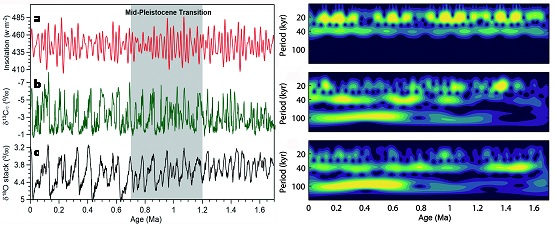In 2005, Science had presented 125 scientific conundrums urgently needed to be solved in the coming future, including “What causes ice ages?” This issue was closely related to onset of the 100-kyr glacial cycles since the mid-Pleistocene transition (MPT). The MPT was widely recognized as a shift in paleoclimatic periodicity from 41- to 100-kyr cycles, which largely reflected integrated changes in global ice volume, sea level, and ocean temperature from the marine realm. However, much less was known about monsoon-induced terrestrial vegetation change across the MPT.
Recently, a team led by Prof. SUN Youbin from Institute of Earth Environment of Chinese Academy of Sciences published a paper in Nature Communications, suggesting that Chinese loess documented a unique MPT reflecting terrestrial vegetation changes from a dominant 23-kyr periodicity before 1.2 Ma to combined 100, 41, and 23-kyr cycles after 0.7 Ma. This study proposed a new concept of diverse manifestations of the Mid-Pleistocene climate transition, induced by varied sensitivity of Earth climate system to astronomical forcing under different ice/CO2 boundary conditions. This new findings provided novel insights into our understanding of monsoon variability and dynamics from the natural past to the anthropogenic future.
Based on paleomagnetic results, 26Al/10Be burial dating and pedostratigrahic comparison of a 430-m high-quality loess core, the team constructed a reliable age model for the loess-paleosol sequences. The loess δ13CIC record (a sensitive summer monsoon proxy) exhibited a significantly shift of the coupled monsoon-vegetation changes from dominant precession cycles before 1.2 Ma to combined 23, 41 and 100-kyr cycles after 0.7 Ma, very different form the conventional MPT. Model simulations revealed that the MPT transition likely reflected decreased sensitivity of monsoonal hydroclimate to 21-kyr insolation forcing as the Northern Hemisphere became increasingly glaciated through the MPT. Our proxy-model comparison suggested varied responses of temperature and precipitation to astronomical and ice/CO2 forcing.

Fig. Variations of monsoon proxy, solar radiation, ice volume and wavelet spectra over the past 1.7 Ma (Image by Sun et al.)
Contact: Bai Jie, Institute of Earth Environment, Chinese Academy of Sciences, Xi'an, China. Email:baijie@ieecas.cn
 © 2015 Institute of Earth Environment,CAS
© 2015 Institute of Earth Environment,CAS Address:No. 97 Yanxiang Road, Xi'an 710061, Shaanxi, China

 Location :
Location :